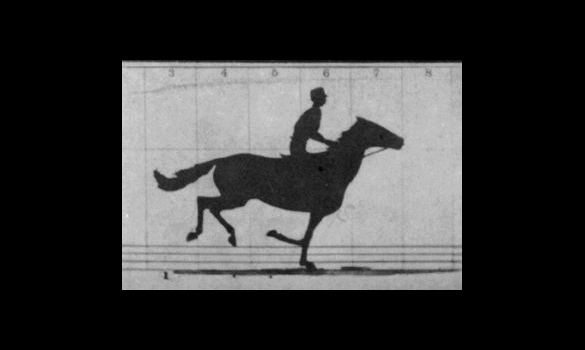From motion photography to seren portraiture, the camera reproduces a reality that the eye trusts. Here’s a look into the non-fictitious nature of reality as rendered by a photograph.
Horses are magnificent beasts that can fly. Well, almost. On one of my trips to the farm where I learnt to ride, I came across a poster of Edward Muybridge's The Horse Motion (1878): 12 continuous frames arranged in a 4X3 grid depicting a horse in gallop. It was commissioned by Robber Baron Leland Stanford, who funded the Central Pacific Railroad and founded the eponymous university. Leland also happened to be a race-horse owner and equestrian enthusiast.
He and his cronies were debating about whether or not all four hooves of a horse remained off the ground during a trot, and by extension, a gallop. A question that had been debated yet incorrectly rendered for years. Stanford decided to prove the idea of 'unsupported transit' scientifically. Then Muybridge walks in the door and is commissioned to put an end to the whole thing. With a photograph. I don't know if it actually happened that way but the two did meet and spoke about this equine conundrum.
It was logical for Leland to assume that the findings be considered scientific proof for a number of reasons. Developing a photograph involved a scientific process and knowledge of such; the amount of time it took to create a photograph, albeit not as quick as it is today, was much shorter than that of an oil or even pastel rendering; and it reproduced a hyper real perspective previously unseen by any person. It was no wonder that photography quickly acquired a following of important minds that deemed the camera to be an objective method of capturing reality.
Muybridge's studies in motion photography represent only part of the fascination with duplicating reality. Portraiture took on a new reality with the photograph, it's focus was to render an objective reality of the sitter. Portrait painting of the renaissance focused heavily on the human form as we actually see it; photo-real as photography came to call it.
The anatomically meticulous humanists of the southern renaissance and Dutch light sensitive naturalists painstakingly studied the human form and light, using oil-based paints that afforded them the temporal luxury of perfecting the colour palette of skin tones and using light as the subject of the painting obscuring the importance of the sitter. However, their works were not photo-real. Without the photograph, which gave the human mind the photo-real perspective, artists like Robin Eley and Ross R. Rossin, would have probably taken years to stumble on such hyper-realism.
But how about we take a step away from perspective for a minute and think about time? The photograph is able to capture fleeting moments and in-between glances, the out-takes of the sitting, so to speak. An authenticity no hyper-real oil painting can apprehend. It is this ability to make tangible the fleeting or the unnoticed that makes photographic portraiture a genre of non-fiction.
An Indian photographer that immediately comes to mind is Kapil Das. His exhibitions titled 154 Neshvilla Roas and Other Stories (I & II) indicate its narrative intention from the get-go. Part 1 tells the story of a home that has been well broken-in, full with an ailing brother and caregiver parents. It focuses on the minutiae within the walls of the house. The portraits and still-lives take on new meaning when juxtaposed with the narrative of devotion that is required to care for a child that cannot care for himself. Part II moves out of 154 Neshvilla into an objective reality. The contain highly posed studio portraits, to a reclining nude, and even some of people reacting to the embalmed specimens of the Janki Maa Touring Museum. Both parts however, whether referring to the still lives or the portraiture, exemplify our tendency to project narratives onto the images we encounter.
Experiments like the one commissioned by Leland Stanford secured photography's reputation of arresting precise moments and therefore being objective. But in the art world, whether in portraiture or otherwise, a photograph’s aesthetic value resides in its narrative power. On the one hand we have the artists of the aesthetic tradition whose images speak volumes of their subjects and on the other we have images created to document and chronicle.
We must be aware throughout that even though the machines that help us capture these aesthetic or functional images may operate the same way, the use of lenses, depth, light, posture, space, props, oh the list goes on, exposes the fact that the camera may be objective in its interpretation of reality. But in the end the photograph, just like my rendition of Leland meeting Muybridge, is only but a single narrative of a duplicitous non-fiction.
Kapil Das is a photographer based in Bangalore. He travels on a yellow motorbike by day and gets up to no good by night.
Waylon D’Mello is a writer breathing-in Pune.
Editor's Note.
The mysterious inner life, like a mischievous child peering into the living room after his bedtime, shows itself at the oddest, most inconvenient hours. You are at your own party, surrounded by food and alcohol and laughter and then poof! There it is, invisible and omnipresent. Your inner life, sweeping in for the kill, overwhelms all your senses and sound reasoning.
Read MoreAlso in this issue
Illusion: Seeing Beyond Seeing
Meaning: In Search of Significance.
Melody: A Different Tune
Rhythm: Ordering Time












